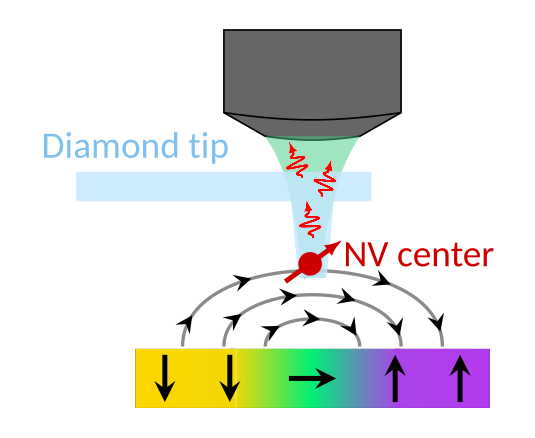NV center magnetometry
The NV center in diamond
The NV center is a defect in the crystalline structure of diamond. Pure diamond is made only of carbon atoms arranged in a cubic structure with 4 neighbours each. However, nobody is perfect and diamond always contains impurities whose presence is revealed by its color. Nitrogen atoms are responsible for yellow diamonds, while boron makes them blue. A NV center consists in a nitrogen atom (N) next to a vacancy (V), i.e. a site in the diamond lattice which sould be occupied by an atom but is actually empty. A diamond with a high concentration of NV centers is pink!

But how is it related with magnetometry? NV centers are a good example of a quantum sensor, a system highly sensitive to external perturbations which you can use accurately measure physical quantities. With a NV center, it is therefore possible to measure electric field, temperature, pressure and mainly magnetic field.
How do you measure magnetic field with this tiny defect?
We measure it optically. When we send a green laser on the NV center, it emits red light called photoluminescence and whose intensity varies with the magnetic field. In more details, the NV center has a spin 1, which means that it has 3 possible states which we call 0, -1 and +1. When the NV center is in the state 0, it emits much more light than when it is in states -1 and +1. If we just send the green laser on the defect, it stays in the state 0. However, if we add a microwave field at a frequency about 3 GHz by passing an oscillating current in a wire placed in close proximity to the NV center, we can bring in the states -1 and +1. And we can detect this by simply noticing that the NV center emits less light!

We have to choose carefully the frequency of the microwave field in order to detect a decrease in the photoluminescence, it has to match exactly with the energy difference between the state 0 and the states -1 and +1. And now the magnetic field enters in the game, by changing the energy of the states -1 and +1 through the Zeeman effect. Consequently, the frequency that we need to observe a drop of the photoluminescence depends directly of the magnetic field value. Since we can measure this frequency very accurately, we are able to detect very small magnetic fields.
A scanning NV magnetometer
In the DIMAF project, magnetic field is measured at nanoscale using a single NV center. This NV center is implanted at the end of a tip made entirely out of diamond and manufactured by Qnami. Our sensor has therefore the size of a atom! To access the magnetic field produced by our sample, we use the tip to perform atomic force microscopy: the tip is so close to the sample surface that it can sense the repulsive forces between the atoms. The distance between the tip and the sample is regulated by keeping this force constant. By scanning the tip over a well-defined area, it provides a map of the topography of the surface. This studied zone is divided into pixels and in each of these pixel, we measure the photoluminescence emitted by the NV center when sweeping the microwave frequency to extract the value of the local magnetic field.

Since it is possible to detect very small magnetic fields, NV magnetometry is a well-suited technique for the study of antiferromagnets.